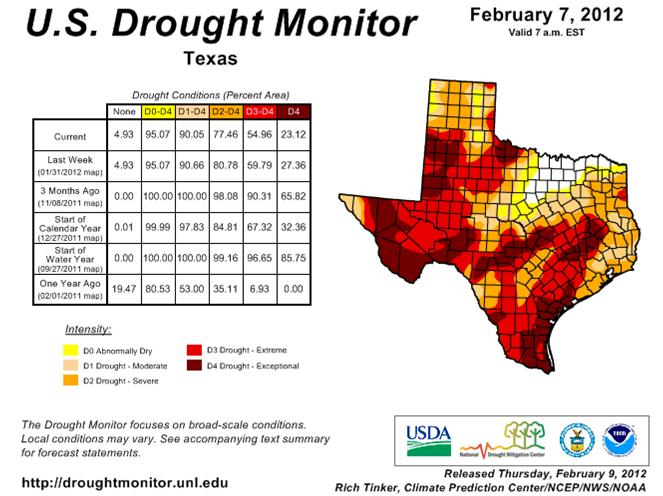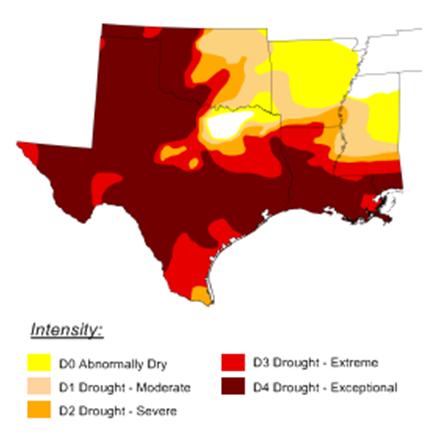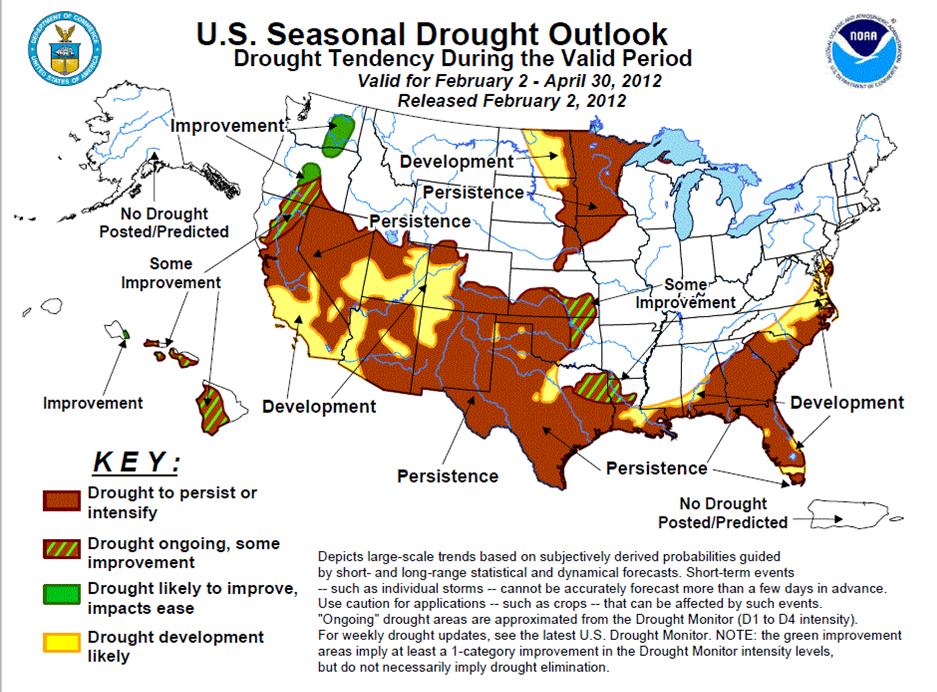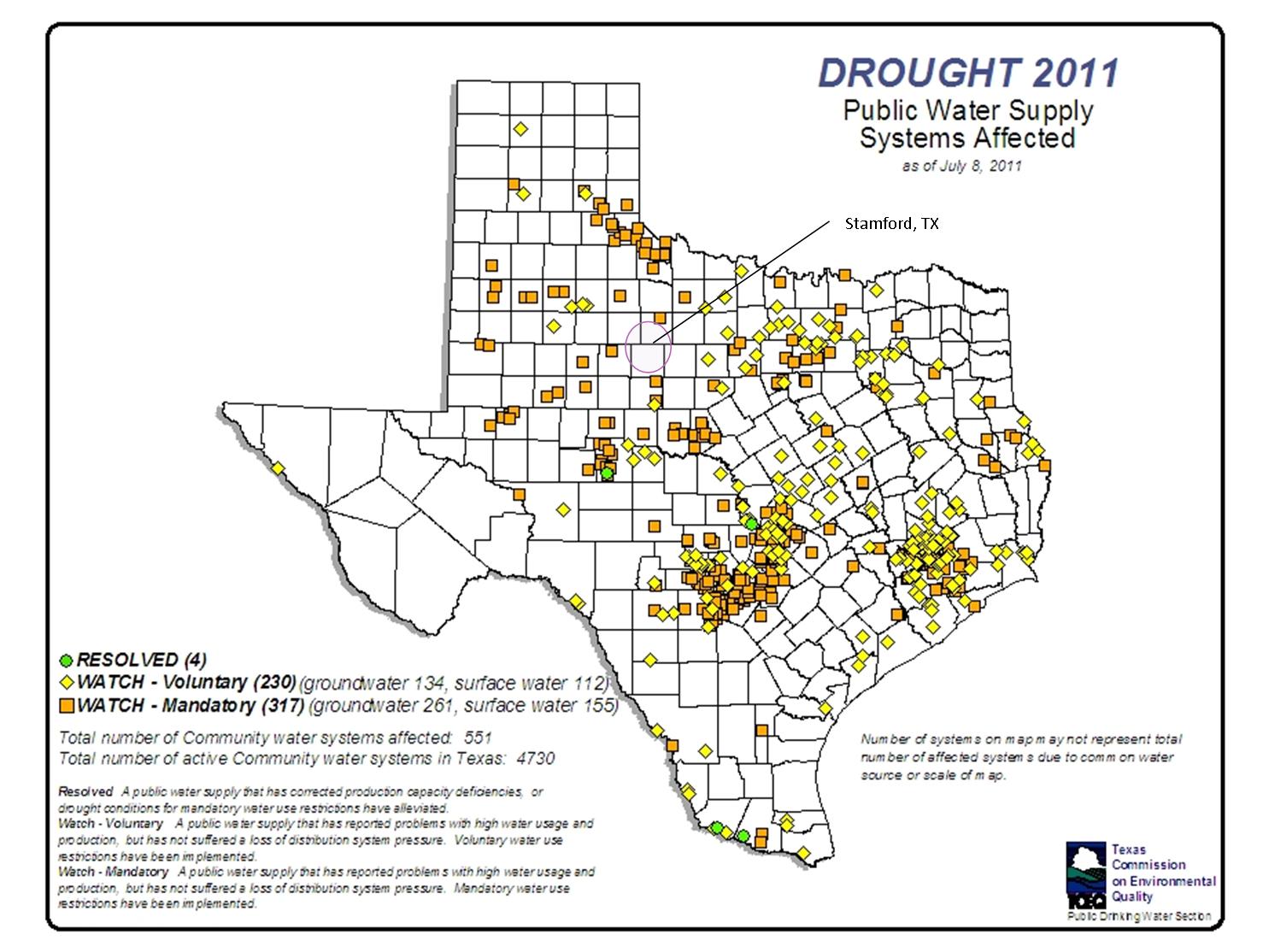 While only 23 percent of Texas remains under “exceptional” drought, 90% of the state is still under some level of drought in spite of the recent rains many parts of the state have experienced. But we can’t get cocky, as the U.S. seasonal drought outlook indicates most of Texas can expect the drought to persist or intensify through April of this year. If we are lucky, the next outlook won’t be so dire as we head toward another Texas summer, hopefully not like our last one.
While only 23 percent of Texas remains under “exceptional” drought, 90% of the state is still under some level of drought in spite of the recent rains many parts of the state have experienced. But we can’t get cocky, as the U.S. seasonal drought outlook indicates most of Texas can expect the drought to persist or intensify through April of this year. If we are lucky, the next outlook won’t be so dire as we head toward another Texas summer, hopefully not like our last one.
Archive for the ‘Coal Plants’ Category
A little bit of rain, a little less drought?
Posted in Coal Plants, Global Warming, Nuclear Plants, Water, tagged drought, Texas on February 10, 2012 |
Bill would give Oklahomans the right to vote on sale of water to Texas
Posted in Coal Plants, Water, tagged Oklahoma, Texas, Water right on January 18, 2012 |
As Texas struggles to determine how they will meet their water needs in the face of what could be an extended 5 to 10 year period of drought, Oklahomans are looking to protect their water rights as their neighbors to the south look on lustfully.
An Associated Press story says proposed legislation by two Oklahoma state lawmakers would require a statewide vote of the people before any out-of-state sale of Oklahoma water. Sen. Jerry Ellis of Valliant and Rep. Eric Proctor of Tulsa said the legislation, dubbed “The People’s Water Act”, would give Oklahomans the final say in deals with other states.
The Tarrant Regional Water District has waged a multi-year legal battle to obtain water from Oklahoma that has so far been unsuccessful. Ellis, who is based in water-rich Southeastern Oklahoma has been one of the most vocal opponents of water sales to Texas and said the future of Oklahoma water should not be decided in private meetings between politicians and Texans.
In the 1870s to 1881 recurrent friction and eventual violent conflict over water rights in the vicinity of Tularosa, New Mexico, involving villagers, ranchers, and farmers were well documented. As the region deals with this extended drought, which some say could be the region’s new norm, could we be looking at more conflicts over water, not only along groundwater sources inside the state, between industrials, urban areas and agriculutural regions, but between Texas and its neighbors?
Read more here: http://blogs.star-telegram.com/politex/2012/01/bill-would-give-oklahomans-the-right-to-vote-on-any-texas-water-sale.html#storylink=cpy
Texas Senator Troy Fraser focuses on the energy industry’s water use
Posted in Coal Plants, Nuclear Plants, Water, tagged drought, Energy, fracking, Texas, water on November 4, 2011 |
According to the Texas Energy Report, Senate Natural Resources Committee Chairman Troy Fraser, called the energy industry a bit too “thirsty” during a record one-year drought, and warned the oil and gas companies to ramp up the recycling of water consumed during hydraulic fracturing.
Currently much of the chemical-laced water and sand that Texas companies blast into shale formations to release oil and gas is later pumped back underground for disposal.
“It’s going to be an issue next session. I continue to tell the industry they’ve got to get aggressive about water reuse,” Fraser, a Republican from Horseshoe Bay in the Central Texas Highland Lakes region, said during a joint interim hearing on drought held by the Natural Resources and the Senate Agriculture and Rural Affairs Committees.
“In a drought situation, it’s starting to be a problem, a big problem in some areas,” Fraser added of the millions of gallons of water used in fracking. “I’ve been projecting for multiple months that this is coming and we’ve got a crisis out there.”
When asked about the water recovery program and how much water is being recovered from fracking, the industry representative responded that he did not have a specific number of how many companies recycle frack water but added that TXOGA has requested data from its members. He noted that while some companies do have significant recovery operations, others do not.
“Significant,”said Fraser. “That implies a lot.” But the numbers from the industry were not there to back that implication up.
Fraser said he’d like to see more efficient water reclamation by cities, manufacturers and refiners as well, but he also took aim at the electric power industry.
“Long-term the power industry is going to hear me talking about figuring out a way to convert and get that technology,” he said. “We can’t continue to use the amount of water that we’ve used in the past. The way we are treating our water right now is not sustainable.”
John Fainter, president of the Association of Electric Companies of Texas, said everyone in the state needs to learn more and do more about conserving and saving and reusing water, but he added a threat of his own. “There is a cost, and the public needs to be aware of that, just like the environmental requirements we’re facing,” he said.
Click here to watch the hearing.
Austin League of Women Voters – Texas Water Study: “Should Water Be Treated as a Commodity?”
Posted in Coal Plants, Nuclear Plants, Water, tagged drought, League of Women Voters, Texas, Water resources on October 31, 2011 |
The ongoing drought, extended high temperatures, and wildfires have increased the importance of state water studies. In light of the study by the State of Texas and the critical nature of our water issues, the League of Women Voters (LWV) Austin is sponsoring a meeting for its members and the public featuring an outstanding panel of water experts to speak on this topic. The panel will address approaches to managing Texas’ very valuable water resources.
Where: Ascension Lutheran Church Family Life Center
6420 Hart Lane, Between 2222 and Far West Blvd., west of Balcones Dr.
The meeting is free and open to the public.
This outstanding panel of speakers, all water professionals, will address water issues inTexas.
- Carolyn Ahrens, Booth Ahrens Werkenthin Attorney – Water Marketing
- David Meesey, Texas Water Development Board Water Planning – The Regional Planning Process
- David Wheelock, LCRA, Manager of Water Supply and Conservation – Surface Water Supply
- John Dupnik, Barton Springs Edwards Aquifer Conservation District – Groundwater Management
- Brian Hunt, Barton Springs Edwards Aquifer Conservation District – Groundwater Management and WaterModeling
You are strongly encouraged to read Facts and Issues: Should Water Be a Commodity? from LWVTX prior to themeeting. Click here to print out a copy.
Continued Drought Concerns ERCOT for 2012
Posted in Coal Plants, Efficiency, Water, tagged drought, electric reliability council of texas, Energy, Energy Efficiency, PUC, Texas on October 19, 2011 |
The worst drought in more than 50 years in Texas is expected to continue as a weak La Nina weather pattern is predicted to strengthen this winter. Drought has already reduced cooling water needed by coal-fired power plants and may limit electric output from power plants next summer, an official from the Electric Reliability Council of Texas (ERCOT – the grid operator) reported.
At this time, only one small generating unit is currently curtailed due to a lack of adequate cooling water, however a continuation of the severe drought in Texas could result in as much as 3,000 MW being unavailable next summer, Kent Saathoff, vice president of ERCOT grid operations told the board last week.
The drought has lowered the water level at nearly every reservoir in the state, according to the Texas Water Development Board. A lack of cooling water limits the ability of a power plant to operate at full capacity.
Texas’ hottest summer on record pushed power consumption to record levels, straining the state’s electric resources on many days in August.
Grid officials and lawmakers are worried that the drought will compound existing issues that impact the state’s power supply: looming environmental regulations that will curtail output from coal-fired power plants and a lack of new power-plant investment.
ERCOT predicts about 434 megawatts would be unavailable next summer if Texas gets about half its normal rainfall over the winter and spring months and if there is no significant rainfall, as much as 3,000 MW could be unavailable by May.
Power plant owners are taking steps to increase access to cooling water by increasing pumping capacity, adding pipelines to alternate water sources and securing additional water rights. Some water authorities have already curtailed new “firm” water contracts, so it may be harder for plants to secure additional water.
The Texas Public Utility Commission should:
- Reward utilities that exceed their energy efficiency goals.
- Use the money from a program set up to provide utility assistance for eligible Texans that is funded by fee Texans pay on their electric bills every month for the weatherization of low-income homes.
And the governor can issue an executive order that requires all state agencies, schools, municipal and county governments to reduce energy use by 5% next summer and report their savings to the state.
You can email the governor and express your opinion by clicking here.
From toilet water to tap water, the new liquid gold of West Texas
Posted in Coal Plants, Water, tagged drinking water, drought, Texas, Water supply on August 12, 2011 |
So after years of diminishing water supplies made even worse by the second-most severe drought in state history, some West Texas communities are resorting to a plan to turn sewage into drinking water.
A water-reclamation plant believed to be the first in Texas will supply Big Spring, Midland, Odessa and Stanton and is currently under construction.
Officials have been working to dispel any fears people have that they will soon be drinking their neighbors’ urine. They are promising the system will yield clean, safe water.
Similar plants have been operating for years in Tucson, Ariz., parts of California and in other countries. Water experts predict other American cities will follow suit as they confront growing populations, drought and other issues.
The Colorado River Municipal Water District in West Texas began considering a wastewater recycling plant back in 2000 and broke ground last month on the facility in Big Spring, about 100 miles southeast of Lubbock. When finished, it should supply 2 million gallons of water a day.
This year’s drought has made this dry region even drier, wreaking havoc on crops, ranch animals, wildlife and fish in the region. At least one of the three reservoirs in West Texas may dry up if the drought persists through next year, as climatologists have predicted could happen, causing the district’s water supply to be reduced from 65 million gallons a day to 45 million.
The idea to recycle sewage isn’t new. Fort Worth and other cities across the nation have long used treated wastewater to water grass and trees and irrigate crops.
And you can be sure the proposed Tenaska coal plant in Abilene is hoping to cash in on that water after having been turned down by the city of Abilene. However, after this year, this region might be reluctant to commit to providing that much water even if it is reclaimed from sewage. Because power plants suck . . . lots and lots of water and they tend to get to do so before crops, livestock and even people.
In the midst of water restrictions, tiny Stamford sells its water to the highest bidder
Posted in Coal, Coal Plants, Water, tagged Coal, drought, Lake Stamford, tenaska, Texas on July 12, 2011 |
Last week, Governor Rick Perry issued a proclamation certifying that certain counties in Texas are currently threatened by exceptional drought conditions and an extreme fire hazard due to a continuing disaster in several counties in Texas, including Jones and Haskell Counties, which the small town of Stamford straddles.
Located 40 miles north of Abilene with a population just over 3,000, Stamford’s city council voted today to sell water to the proposed Tenaska coal-fired plant. It is expected that Stamford would provide about 780,000 gallons (or roughly three-quarters of the minimum amount of water needed by the plant) daily from Lake Stamford, a reservoir formed by Stamford Dam with a storage capacity of 51,573 acre·ft. The average depth of Lake Stamford is only 11 feet. The 2011 Brazos G Water Plan (Vol. 1, p. 4A-7) projects Stamford will have a deficit of nearly 3,000 acre-feet a year by 2030 without the Tenaska contract.
There was no public hearing before the City Council voted, and there were some people present who disagreed with the decision.
Last night, Tenaska hosted an open house. Over a hundred people showed up, the majority of whom were opposed to the water contract, and while some members of the city council and the mayor were present, they still chose to approve the water contract.
Heat and drought; what’s a state to do?
Posted in Climate Change, Coal Plants, Nuclear Plants, Water, tagged drought, National Climatic Data Center, temperature, Texas on July 11, 2011 |
 We’ve blogged numerous times about the persistent heat and drought plaguing the Southern Plains (particularly Texas) this year. Much of Texas is off a June that ranks among the top five hottest in history. According to the National Climatic Data Center, Texas had their hottest June on record and of the six record hottest June cities, 5 were in Texas.
We’ve blogged numerous times about the persistent heat and drought plaguing the Southern Plains (particularly Texas) this year. Much of Texas is off a June that ranks among the top five hottest in history. According to the National Climatic Data Center, Texas had their hottest June on record and of the six record hottest June cities, 5 were in Texas.
-
Record hottest June in Texas, surpassing June 1953!
-
Record hottest June cities: Lubbock, Midland, San Angelo, Houston, Galveston, Wichita Falls, and Columbus, Ga.
There has been no letup in July so far and the number of days with 100-degree temperatures continues to climb. Since the beginning of June to the beginning of July, Texas has seen the highest levels of drought — rated as “exceptional” — jump from 50.65 percent of the state to 72 percent of the state.
Dallas, Texas
- 16 100-degree days through July 10 —the annual average is 18 days;
- Most 100-degree days in a year: 69 in 1980.
Austin, Texas
- 27 100-degree days through July 10 —more than double the annual average of 12 days;
- Most 100-degree days in a year: 69 in 1925.
Even if you don’t believe in anthropogenic climate change, the last 10 years have been the hottest in the last 440,000 years, at least if the Vostok and Greenland ice cores are any indication. And whether or not you think we can mitigate global warming, here in Texas we need to carefully consider one of our state’s most precious resources, WATER!
So when industries, like coal-fired power plants, nuclear plants, natural gas fracking – to name a few that use large amounts of water, are about to sign contracts with the water districts, or river authorities, we should all show up and demand that they show us we indeed will have water available for the people who live in the area.




